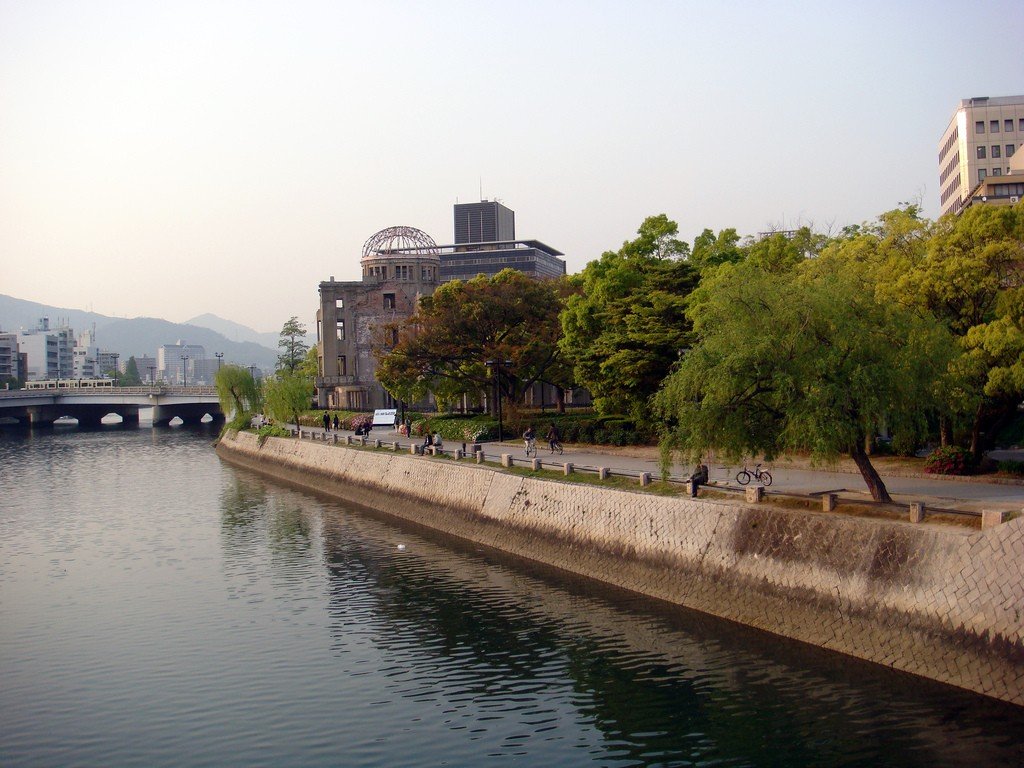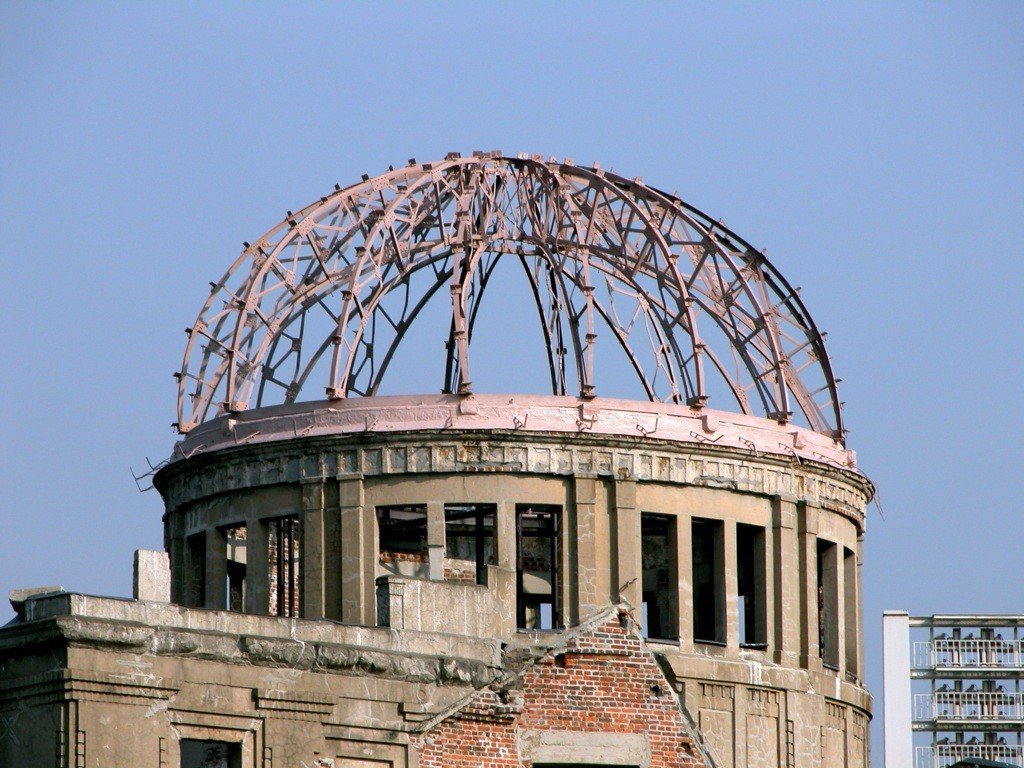Hiroshima Peace Memorial
Hiroshima Peace Memorial is a symbol of the aftermath of the most destructive force ever created by humans, the nuclear bombing. This memorial was not created to honor notable events or people, nor does one come to it to be proud or happy. The Peace Memorial is an old, dilapidated three-story building with a rounded dome – almost all that survived the 4,000 kg uranium bomb dropped on Hiroshima. The building covers an area of 1,023 m² in the historic center of the city, on the banks of the Ota River. The Japanese themselves call it the “Atomic Blast Dome” or “Gembaku Domu” because of the large dome that crowns the structure. The Hiroshima Peace Memorial reminds us with a mute reproach of the terrible pages in human history, the fragility of the environment, senseless death and suffering.
.
In 1996, Gembaku Domu was inscribed by UNESCO as a World Heritage Site. This high international recognition was given to the Peace Memorial as the most important monument commemorating the catastrophic consequences of the nuclear bombing of civilians. The site is the most visited attraction in Hiroshima. Familiarity with Gembaku Domu is even included in Japan’s school curriculum so that the younger generation will never repeat the horrific mistakes.










Video: Hiroshima Peace Memorial
Contents- What was at the site of the memorial at the time of the tragedy
- History of the appearance of the Peace Memorial
- Peace Memorial Park
- How to get there
What was at the memorial site at the time of the tragedy
The two Japanese cities of Hiroshima and Nagasaki suffered a terrible tragedy: on August 6 and 9, 1945, U.S. forces used nuclear bombs against them. For the first and last time in history, the U.S. Armed Forces dared to use nuclear weapons to hasten Japan’s surrender at the end of World War II.
.
The building that now houses the Peace Memorial came to Hiroshima in 1915. It was built in the European tradition, which was new to Japan at the time. It was a 3-story house built by Czech architect Jan Letzel. The middle five-story part of the brick building was topped by a 25-meter-high dome. Here from the main entrance one could climb up an internal staircase. The walls of the building were faced with stone and cement plaster. The Exhibition Center, which belonged to the Hiroshima Chamber of Commerce and Industry, was located here. The building housed various organizations, exhibitions and cultural events.
.
When the terrible explosion occurred on an August morning in the city, the Gembaku Exhibition Center was home to employees from the offices of shipbuilding and woodworking companies, the Chinese Ministry of the Interior, and civilian construction personnel. All of these people tragically lost their lives.
.They had no chance to survive: an American B-29 “Enola Gay” bomber dropped a “Little Boy” bomb with the equivalent of 13 to 18 kilotons of TNT just a hundred meters from the building! More than 60% of Hiroshima’s buildings were destroyed by the massive explosion and the devastating fire that followed. And only the Exhibition Center, located 160 meters from the epicenter, was able to withstand. However, only load-bearing structures and the dome hull remained. Partitions, floors and ceilings collapsed on people, and the interior premises were instantly burnt out by the flames. A total of 140,000 residents of Hiroshima died on that tragic day, and in the following years another 250,000 people died from the effects of radiation exposure.
.History of the appearance of the Peace Memorial
In rebuilding the city, most of its structures had to be rebuilt, so severe was the damage from the nuclear bombing. The decision to save the remaining part of the building with the dome was made in 1953. The structure, standing amidst the ruins, was so impressive that it could be turned into a unique monument for the edification of posterity.
.
But the creation of the memorial was not taken up immediately. There was too much work to restore normal city life. For all the ideas did not have enough time, nor material means, nor human resources. They managed to restore normal life in the city only by the early 1960s.
.In 1962, the building was fenced with construction nets and prohibited entry to outsiders. By this time, the derelict ruins were overgrown with weeds, cracks in the walls had widened, and the corroded steel frame of the dome was about to collapse. Four years later, the mayor of Hiroshima asked citizens to raise funds to restore Gembaku Domu. In 1967, the first restoration took place. Then several more times the dome and walls of the building were carefully reinforced on the inside.
Now the memorial dome looks as it did in the first moments after the explosion. A stone has been placed next to it, on which you can see many bottles of drinking water. They are placed here in memory of Japanese people who survived the atomic bombing but died of thirst afterward when the city was engulfed in flames.
.Peace Memorial Park
On the opposite bank of the Ota River, opposite Gembaku Domu, is the 122,000 m² Peace Memorial Park. It was created at the site of the epicenter of the atomic explosion, and before World War II was the political and commercial center of Hiroshima. The park now houses displays of the Memorial Museum, a ritual bell, several monuments and a collective headstone of all the victims.
.
The Main Building of the museum features exhibits on the history of the nuclear bombing of Japan. And the East Building is dedicated to telling the story of Japan’s participation in World War II.
Every year, on August 6, a mourning ceremony is held at Hiroshima Memorial Park. Bells toll over the city, and at night, people launch lighted paper lanterns into the river, symbolically advocating for peace. Participants in the ceremony remember those who died and place wreaths of remembrance on a common tombstone, the Cenotaph, on which are carved the words, “May your souls rest in peace, evil will never happen again.”
How to get there
To get to the Hiroshima Peace Memorial, you need to get off at the Hakushima subway station and take the #2 or #6 streetcar from there to the Genbaku-Domu mae stop. The ride takes about 15 minutes. Peace Memorial Park is open to visitors from 8:30 a.m. to 6 p.m. (until 7 p.m. in August and until 5 p.m. from December through February).
.